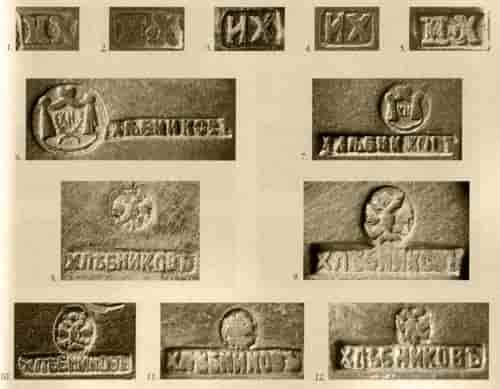Авторство Хлебников Иван Петрович
Купить серебро Хлебников Иван Петрович 1871-1917 гг. Продажа серебрянных предметов антиквариата на art-picture.ru
Авторство Хлебников Иван Петрович 1871-1917 гг
Фабрика И. П. Хлебникова, 1871-1917 гг
Немало сведений сохранилось о ювелирных шедеврах предприятия Ивана Петровича Хлебникова. Но совсем немногое известно о личности фабриканта и его жизни, особенно до момента основания фабрики. Будущий фабрикант родился в 1819 г. Отец его Петр Хлебников купеческое свидетельство получил в 1832 г. и, возможно, имел свое ювелирное производство. Где и какое образование получил молодой Иван не известно, он с юных лет, вероятно, работал в организации своего отца, затем продолжил его дело, поскольку Иван Петрович, в сохранившихся документах, упомянут купцом 1-й гильдии, торгующим серебряными, золотыми и бриллиантами вещами в Серебряном ряду Городской части. Ивану Петровичу исполнилось 52 года, когда он открыл в 1871 г. московскую фабрику изделий золотых, серебряных, бриллиантовых "в Яузской части, в доме Нарышкина". Главное здание и поныне стоит на углу Яузской улицы и переулка Рюмина, по которому тянутся бывшие фабричные корпуса. Иван Петрович, около 40 лет занимающийся торговлей драгоценными произведениями, приобрел отменные технические знания во многих направлениях ювелирного искусства.
Известность и успех Хлебникова возрастали невероятно стремительно. Год спустя после открытия, организация официально стала поставлять ко двору Великого князя Константина Николаевича, брата императора Александра II, драгоценности. Впредь, деятельность фабриканта и его предприятия будет хорошо прослеживаться.
Спустя еще год изделия Хлебникова высоко оценила Европа. В 1873 г. ювелир получил две медали на Всемирной выставке в Вене, показав богатую коллекцию предметов, выполненных в русских творческих традициях. Эмалевая и чеканная работы были неимоверно искусными. Особенное внимание привлек складень сложной и прекрасной работы, створки которого были выполнены цветными перегородчатыми эмалями.
Магазины фабриканта находились в лучших торговых местах: в Серебряном ряду, на Кузнецком мосту, Ильинской улице в Москве, на Невском проспекте в Петербурге и в Нижнегородске на главной ярмарочной линии. На предприятии работало около ста рабочих. Были открыты скульптурная и рисовальная школы.
К 1877 г. предприятие становится поставщиком Нидерландского, Датского, Черногорского, Сербского княжеских и королевских дворов, а также двора Великого князя Владимира Александровича, брата императора Александра III.
В 1879 г. сбылась долгожданная мечта ювелира. Он получил право именоваться поставщиком Высочайшего Двора и ставить на изделиях изображение государственного герба.
К 1880 году расширенное производство превратилось в высокотехническое предприятие с мастерскими, где работало около 300 умельцев золотарей, медников, серебряников, чеканщиков, эмальеров, филигранщиков, галантерейщиков. Учитывая разросшиеся масштабы, участие в деле сыновей Михаила, Алексея, Николая, Владимира, в 1880 году был создан торговый дом «И.П. Хлебников с сыновьями и К°».
Почил и был похоронен Иван Петрович в 1881 году. Последним его пристанищем стал Спасо-Андроньевский монастырь. Но дело его продолжало процветать. Наполняя магазины всевозможной ювелирной продукцией различной стоимости, выполняя заказы именитых российских и зарубежных особ, изготавливая соборные и храмовые шедевры, фирма разрасталась. В 1887 г. наследниками было образовано акционерное «Товарищество производства серебряных, золотых и ювелирных изделий И.П.Хлебникова, сыновья и К°». То была новая форма правления с начальным капиталом 660 000 руб. К расширившемуся предприятию перешла фабрика, московские и петербургские магазины одной из старейших российских фирм Сазикова. Компания, совершенствуя техническое оборудование, приобрела для завода паровой котел и две паровые машины, что было весьма прогрессивным в те годы.
Закрыта фабрика была летом 1917 года, после чего национализирована большевиками в1918 г. и преобразована в «Московский платиновый завод».
Выпускаемая продукция, особенности техники
Основным направлением, созданных Хлебниковыми работ, был русский стиль, который гармонично сочетался со сдержанным и пластичным модерном. Воспроизведенные эмалями национальные орнаменты, выглядели, словно мельчайшая роспись кистью, или выложенная самоцветами мозаика. В такой технике покрыты столовые и письменные принадлежности, портсигары, табакерки, ларцы, солонка в форме трона. В посуде из драгоценных металлов угадывались формы русских ковшей, чарок, братин, чаш. Чернильницы в виде русских теремов, утварь в стилизованной форме либо изображениями жар-птиц, лебедей, петухов. Альбомные пластины и посуду украшали барельефы отображений жизни Сергия Радонежского, Иоана Грозного, сцены русского хоровода и сказаний. Серебряные интерьерные скульптурки на тему фольклора и крестьянской жизни были выполнены с неотразимым изяществом, тончайшим образам проработаны мелочи. Пучков, лучший чеканщик фирмы, в серебре мог выразить фактуру ткани, волос, и даже мягкость тела.
Мастера Хлебникова были из лучших в чеканном деле и особо преуспели в искусстве перегородчатой эмали. Они составляли конкуренцию в этой сложнейшей эмальерной технике самому П. Овчинникову, непревзойденному специалисту. В технике живописной эмали многие произведения украшались миниатюрами, а эмаль со сканью превращала изделия в кружева.
Массовые серебряные предметы были настолько чистой красивой формы и качественного изготовления, что при минимуме декора или вовсе без такового пользовались большим спросом. Несколько таких изделий выставлено в галерее антикварных подарков Лермонтов: подстаканник, сочетающий стиль модерн и классический русский орнамент, и серебряная с гравировкой столовая ложка 1887 года классической формы.
Сочетание технического совершенства, оригинальных замыслов и глубоких познаний национальных традиций наилучшим образом выразилось в предметах для православного богослужения. Совершенство линий, строгость и роскошь немыслимым образом сочетались в чеканных орнаментах икон, крестов, окладов, складней, кадил, чаш, украшенных каменьями, писаными миниатюрами и эмалью. Эти великолепные вещи были всегда востребованными глубоко верующими россиянами.
За способность Хлебниковых к созданию монументальных шедевров их фирма неоднократно была удостоена заказами Московского Кремля. Создание церковной утвари для храма Христа Спасителя в 1883 г. По заказу Московского Кремля оформлялся иконостас Благовещенского собора в 1896 г. Для Успенского собора товарищество занималось выполнением пристенных икон и киотов, надгробий для митрополитов и патриархов, созданием иконостаса в приделе Дмитрия Солунского с 1898 г. по 1915 г.
Клейма фабрики Хлебникова
Приведенные ниже клейма датированы 1874—1917 гг. Это не все известные образцы. Предприятием, к сожалению коллекционеров, использовалось большое количество пуансонов.

Герб великого князя Константина Николаевича может быть вытеснен рядом с именником фабриканта, а двуглавый орел появляется с 1879 г. После смерти Ивана Петровича, с 1882 г. краткое клеймо с инициалами не ставилось, а только «ХЛЕБНИКОВЪ» или «ХЛЕБНИКОВЪ СЪ СЫНми и К°».

